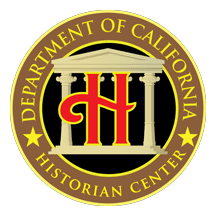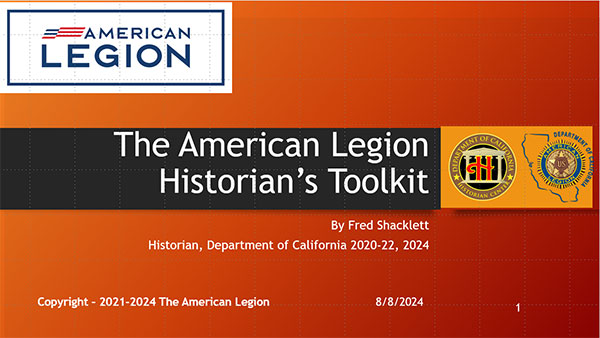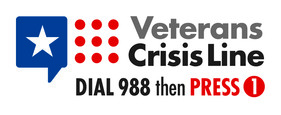Historian Center
“The Long Line: Department of California”
This video chronicles the Legionnaires who have served as Commander of the Department of California from 1919 to present day. Fred Shacklett, Department Historian (Post 51) and Michael Toschack, Department Web Team (Post 105) collaborated on the development of this wonderful historical video.

Post and Department Histories
The American Legion strongly encourages the preparation of histories. Such information on activities will be of considerable value in years to come.
National Headquarters is aware that a professional historian does not usually fill the position of historian. This should not prevent a proper recording of activities. The scope of the information included is the main consideration, keeping in mind, however, comprehensiveness, readability, and arrangement, to make the history both an interesting account and a reference source.
At the start of the new Legion year, the historian begins making a permanent record of the organization for the year ahead, from the installation of officers up to and including the installation of next year’s officers. To help gather specific details ask the adjutant for copies of the most recent Consolidated Post Reports. The statistical summary will indicate the type and amount of activity that can help you put together as complete a picture as possible. Make plans to compile a complete history if there has not been one done recently, but focus, for the moment, on a one- year history. Then go back to the files and gradually write up the back story.
The national historian will conduct a one-year history contest for post and department-level entries. One post entry and one department entry may be submitted by each department. These ongoing national contests will give stability and continuity to the recording of events for future generations of Legionnaires. The department historian will notify posts of any national contest changes that may occur.
Included in this guide is an outline to compile a one-year history with judging standards for competition in the national contests to be conducted in August of 2024 for the 2023-2024 Legion year. Information on the 2023 contest is in the 2022 Officer’s Guide.
To be eligible for the national contest, an entry must be a first-place winner in the department’s contest, be certified as such by the department adjutant and be uploaded by the department to the contest website by August 1. Department historians or adjutants need to contact the national historian or National Headquarters’ Library and Museum director for exceptions.
The work of collecting, preserving and recording the activities of The American Legion is an important endeavor and demands much detail work; hopefully you will find it inspiring and rewarding. Contact the department historian for additional ideas and information regarding department contest qualifications.
Outline for a one-year history
This outline has been developed to be helpful to the historian. It would be advantageous to check any compilation against this outline to include as much of the material suggested here as possible.
Format
Presentation – A single PDF file not to exceed 50MB in size (smaller files are preferred).
Title page
This will be the first page when the file is opened. It should be in a logical arrangement with double spacing or more and contain as a minimum the following:
History of
(Name of post) Post No. Department of The American Legion
(city and/or state) For 20 to 20
By (person(s) compiling history)
Introduction
Every history should include a forward or introduction setting forth the reasons for the organization and may include:
- Mention of the national organization’s founding (including the Preamble to the Constitution of The American Legion) with a tie-in of the department and post’s history. See legion.org/history or “Capsule History of The American Legion,” listed later, as a possible beginning, and see your department historian for a capsule history of the department.
- If named for a departed comrade or comrades, include a short biographical sketch of their lives and include available photographs.
- If possible, a brief résumé of your community’s history, especially the part played by that locality in furnishing men and women during wars and conflicts.
- A photograph of the building and street address, as
- Acknowledgment of any assistance or contributions used in compiling the
Table of contents
This is a must for any good history, which will list the pages of the chapters and appendices and should be in the front of the history immediately following the introduction.
Index
The alphabetical index is a must for any good history. This comprehensive index of names, places and events mentioned in your history, with page references, shall be at the end of the history following the appendices. Be sure to include every person and activity in the history. If a person has a title, put that in with a cross-reference to the name.
Page numbering
Do not forget to number the pages. Be consistent in placing page numbers, either at top or bottom of pages.
Chapters
One-Year Summary History – This should be a one-year chronicle. The history is to cover one year, beginning with the installation of officers, up to and including the installation of the next year’s officers. This timeframe may vary in some departments. This is the most important chapter in your
history and must be as complete as possible. The historian should relate all important events and programs conducted during the year or events conducted jointly with the Auxiliary, Sons of The American Legion, or county, district, department and national levels. Historians may use information from the minutes of meetings as a basis for information about the post’s activities. Then contact members who were chairs of the committees for further details. Include anything that you deem a special attribute of the post, setting it apart from all others.
While many American Legion programs and projects are of a continuing nature and may run through several administrations, such activities might be better covered in a separate chapter following those devoted to the individual administration. The activities of all standing committees should be given considerable coverage, particularly if one committee performs an outstanding service. You may want to include each committee in separate chapters: Americanism, Membership, Boys State, School Award Medals, Oratorical Contest, Junior Shooting Sports, Baseball, Children & Youth, Sons of The American Legion, patriotic observances, parties, Boy Scout troops and other sponsored groups, to name a few. Collect and record for posterity all activities, including photographs adds to the attractiveness of the entry. Give attention to the arrangement of illustrations in relation to the text and use of captions (identification) under each photograph.
Appendices
Appendices are pages of statistical data that should be carried at the end of the history, following the chapters and before the index, and might include:
- Roster of Officers – Photographs of current officers should be included in the history. If it is not possible to obtain photographs of every officer, make a special effort to include photographs of the commander and the adjutant.
- Roster of Chairmen – Include a roster of chairs with photographs, if
- List of charter members and dates of temporary and permanent
- A roster of all past commanders and adjutants since the charter date with their years
- Posts may want to add a roster of members listed in alphabetical This may include, after each member’s name, the member’s branch of service or the date he or she joined the post.
- A record of the citations and awards received, as well as awards
- A list of members who served as delegates to the national and department conventions, or national and department officers and commission and committee appointees, including the county and district.
- Complete records of annual elections showing all nominations and votes received by various nominees.
- Membership standings by year since the charter date; a list of new members for the current year; a list of life members and Paid-Up-For-Life (PUFL) members; ”In Memoriam,” also known as Taps or Post Everlasting, listings for the current year; the constitution and by- laws; the annual budget; and any other important statistics.
Readability
The emphasis should be on the narrative rather than the statistical style of presentation. Use your imagination and be original in thought and presentation. A high degree of literary style is not essential to success, but the method of presentation should be pleasing to the general reader. The reader must be able to follow the story without difficulty or confusion. The most common error is in not writing in the third person. This means you should write as an observer, not as a participant. The history should be written as a chronological and detailed account of events arranged in order of time without any analysis or interpretation. Statistics are of great value but should be included in the appendix rather than being placed indiscriminately throughout the book.
Photographs/Illustrations
All photographs must be identified by occasion, individuals, date and place of event with the exception of individual photographs of officers and chairs (name and title/committee only). Provide left-to-right subject identification, and if necessary, by row.
Be sure all photographs are clear, as blurry prints will not aid materially and will take away from rather than enhance your history. Proper arrangement with the text is a must to achieve an eye- catching history book. Avoid using pictures with alcohol or cigarettes in them.
Judges Option / Originality
Under this category, judges will consider a number of qualities or items of content in the history that are not readily cataloged under the preceding headings. Some histories, for example, have a complete roster of members. In other words, judges will determine features that make a history especially attractive or useful. By the same token, if inaccuracies come to the judges’ attention, they would have a negative scoring effect.
Page format suggestions
Use a page format and layout that will be accessible when viewed on multiple types of devices or when printed.
National judging standards
|
|
Post or Dept History Judging Form |
|
10 Points |
PRESENTATION Single PDF file with pleasing formatting and layout. This includes font, margins, spacing, etc. |
|
10 Points |
INTRODUCTION Background, tie-in with department and national, community, Preamble to Legion Constitution, etc. |
|
15 Points |
TABLE OF CONTENTS, INDEX AND PAGE NUMBERING Page reference of chapters, appendices, etc. |
|
15 Points |
ORGANIZATION Logical order, not to detract from general readability |
|
20 Points |
NARRATIVE Rather than a statistical style of presentation |
|
20 Points |
IMAGES All photographs are clear and must have names, occasions, sources, dates, etc. Provide proper left-to-right identifications |
|
10 Points |
JUDGES WILL CONSIDER qualities or content not readily cataloged under the preceding headings including features that make a history |
|
|
especially attractive or useful as a source of reference and historic value. |
|
100 Points |
|
Research Suggestions
In the event that records are missing and there is no history, the historian may search the local newspaper files and interview past commanders, adjutants and older members. Many important events can be found using these methods.
Information about post charter applications can be obtained by post adjutants or commanders by contacting the national charters clerk, Internal Affairs & Membership Division at IA@legion.org.
Many departments have organized department historian associations, patterned after the National Association of Department Historians of The American Legion (NADHAL). These groups render assistance in carrying out a successful historian’s program. Ask if your department has such an organization and join in its activities. If there is no such department organization, consult your department historian.
The serious historian will find informative and interesting any one of the following published histories about The American Legion.
- Michael Bennett’s “When Dreams Come True: The GI Bill and the Making of Modern America” (Brassey’s, 1996)
- Thomas Rumer’s “The American Legion: An Official History” (M. Evans, 1990)
- Raymond Moley’s “The American Legion Story” (Duell, Sloan & Pearce, 1966)
- Richard Jones’ “A History of The American Legion“ (Bobbs-Merrill, 1946)
- Marquis James’ “A History of The American Legion” (William Green, 1923)
Where possible, use digital voice recorders or video cameras to record oral histories and interviews of American Legion leaders to capture firsthand history.
Helpful hints for district/county historians
Some departments use the district and county structures, and historians at both levels must make a team effort to accomplish their respective responsibilities to posts in their jurisdiction. If you have been elected or appointed district/county historian, your primary duty is to coordinate the records of post activities within your district/county to ensure the preservation and accessibility of such records at all times.
Some departments conduct comprehensive spring and fall district meetings. If this is the case in your department, make every effort to be allotted time on the program. Travel to posts within your district with the district commander and his or her staff whenever possible and speak at post meetings. Use the spring meetings as your vantage point for administering a final “morale booster” to the work-shy in your district. Emphasize the importance of adequate records and of giving all possible help and encouragement to post historians. Many district historians have had no experience in this type of work. In addition, many posts have never tried to keep a history of
any kind. You will have to begin by researching and compiling as much information as possible from past records, then focus on keeping your own records current.
Be sure that every post in your district has a post historian and that they are kept informed of the latest developments and material. It is your duty to give all possible aid to post historians within your district. If your department conducts an annual post history contest, encourage the historians to enter. Your department may conduct an annual district/county history contest. Naturally, some material suggested would not be appropriate for district or county books.
Capsule history of The American Legion
A group of 20 officers who served in the American Expeditionary Forces (AEF) in France during World War I is credited with founding the Legion. AEF Headquarters asked the officers to suggest ideas on how to improve troop morale. One officer, Lieutenant Colonel Theodore Roosevelt Jr., proposed an organization of veterans. In February 1919, the group formed a temporary committee and selected several hundred officers who had the confidence and respect of the whole army. About 1,000 officers and enlisted men attended the Paris Caucus in March 1919. They adopted a temporary constitution and the name The American Legion. The group also elected an executive committee to complete the organization’s work. It considered each soldier of the AEF a member of the Legion. The executive committee named a subcommittee to organize veterans at home in the United States. In May 1919, the Legion held a second organizing caucus in St. Louis. It completed the constitution and made plans for a permanent organization, setting up a temporary headquarters in New York City and beginning its relief, employment and Americanism programs. Congress granted the Legion a national charter in September 1919. The first national convention convened in Minneapolis on November 10-12, 1919, adopting a permanent constitution and electing officers to head the organization. Delegates also voted to locate the Legion’s national headquarters in Indianapolis, Indiana. The Legion continues to support the four pillars of service and advocacy upon which it was founded: Veterans Affairs and Rehabilitation, National Security, Americanism, and Children and Youth.
The American Legion’s centennial website
As part of The American Legion’s 100th anniversary celebration, a special website was created: legion.org/ centennial. Though the centennial is past, each post is encouraged to add its history. Post pictures and histories are important to share with other posts, departments and the entire community. Ideally, every post will be listed on the centennial website.
The Officers Guide of The American Legion states this about the Historian:
Historian
The work of post historian is cumulative. It is wise to leave the responsibility to one person if handled well.
There should be close cooperation between the post adjutant and the historian. The former works with records on matters of current interest, the latter on matters of historical interest. The post historian should also keep in touch with the department historian and be prompt in answering inquiries. An annual report
should be made to the department historian prior to the department convention.
Copies of printed material regarding the post should be deposited in local and state libraries, as well as in the post and department archives. This will prevent complete loss of records through fire or other catastrophe, as well as provide source material for those looking for information about The American Legion. An outline for a one-year post narrative history and yearbook is provided in the appendix (see pages 124-133).
18 THE AMERICAN LEGION | OFFICER’S GUIDE | 2021
The post historian should attend department conventions and make a point of knowing what historians of
nearby posts are doing. The department historian can advise post historians on department and national
post history contests, historians associations, and materials to assist in maintaining best practices.

Historian Resource
- California National Conventions
- org/history
- NADHAL* | The American Legion
- NADHAL* NEWSLETTER
- Post Data Archive Template
- The Historian Toolkit (PDF)
- Legion Brand Mark Guidelines
* National Association of Department Historians
A post yearbook is a pictorial history of the post’s annual activities. Remember, though, that this is a permanent record that will be seen by others for years to come, so the suggested outline should be followed as closely as possible. It would be advantageous to check any compilation against this outline so as to include as much of the material suggested here as possible.
List of Department Historians
| From | To | Name |
| 2024 | 2025 | Fred Shacklett |
| 2023 | 2024 | Lillian Moss |
| 2023 | 2024 | Auggie Galaviz |
| 2022 | 2023 | Fred Shacklett |
| 2021 | 2022 | Fred Shacklett |
| 2020 | 2021 | Fred Shacklett |
| 2019 | 2020 | Henry Sanchez |
| 2018 | 2019 | Wayne Yee |
| 2017 | 2018 | Wayne Yee |
| 2015 | 2016 | Lillian Moss |
| 2014 | 2015 | Richard Carpino |
| 2013 | 2014 | Edward M. Alvarez |
| 2012 | 2013 | Joseph F. Handy |
| 2011 | 2012 | Joseph A. Garcia |
| 2010 | 2011 | Kevin E Kilkenny |
| 2009 | 2010 | Steven C Weber |
| 2008 | 2009 | S R Barghoon |
| 2007 | 2008 | Raymond C Baxter |
| 2006 | 2007 | Henry Hosea |
| 2005 | 2006 | Marilyn E Rideaux |
| 2004 | 2005 | Bud Simmons |
| 2003 | 2004 | Walter J Quinn |
| 2002 | 2003 | James N Creacy |
| 2001 | 2002 | John M Lighthill Sr |
| 2000 | 2001 | George G Briggs |
| 1999 | 2000 | Charles P Wendt |
| 1998 | 1999 | Kelly M Sanders |
| 1997 | 1998 | Marian F Landis |
| 1996 | 1997 | David R Glover |
| 1995 | 1996 | Bobby O Mahaffey |
| 1994 | 1995 | Lawrence E Johnson |
| 1993 | 1994 | Elmer L Caster |
| 1992 | 1993 | James Higuera |
| 1991 | 1992 | Elmer L Caster |
| 1990 | 1991 | Joseph O Early |
| 1989 | 1990 | Paul McGinnis |
| 1978 | 1979 | Daniel O’Brien |
| 1977 | 1978 | John C Hallyburton |
| 1976 | 1977 | Sylvia S Hendry |
| 1975 | 1976 | LeReine Maxey |
| 1974 | 1975 | Norie White |
| 1973 | 1974 | Dorothie Raymond |
| 1972 | 1973 | Phyliss Meyer |
| 1971 | 1972 | Evelyn Wallace |
| 1970 | 1971 | John J Bettencourt |
| 1968 | 1969 | Hope Kennedy |
| 1967 | 1968 | Anna T Brown |
| 1966 | 1967 | Richard Michling |
| 1964 | 1965 | Florence Land |
| 1963 | 1964 | Merle M Birnie |
| 1962 | 1963 | Natalie Harper |
| 1961 | 1962 | Juanita Wright |
| 1960 | 1961 | Rachelle Baker |
| 1959 | 1960 | Frances Avila |
| 1958 | 1959 | Rebecca Wyland |
| 1957 | 1958 | Virginia Farber |
| 1956 | 1957 | Loyce Cook |
| 1955 | 1956 | Gertrude Denham |
| 1954 | 1955 | Louise Graham |
| 1953 | 1954 | William Bucknam |
| 1952 | 1953 | Hope Kennedy |
| 1951 | 1952 | Daisy Ulrich |
| 1950 | 1951 | Al Weinberg |
| 1950 | 1951 | Walter Naughton |
| 1949 | 1950 | Walter Naughton |
| 1948 | 1949 | Arthur Atkinson |
| 1947 | 1948 | Walter Naughton |
| 1946 | 1947 | Walter Naughton |
| 1944 | 1945 | Walter Naughton |
| 1943 | 1944 | Walter Naughton |
| 1942 | 1943 | Walter Naughton |
| 1941 | 1942 | Walter Naughton |
| 1940 | 1941 | Walter Naughton |
| 1939 | 1940 | Walter Naughton |
| 1938 | 1939 | Walter Naughton |
| 1937 | 1938 | J A Bennett |
| 1936 | 1937 | Otto Hintermann |
| 1935 | 1936 | Floyd Helmick |
| 1934 | 1935 | Walter J Rerce |
| 1933 | 1934 | Joseph Chrisman |
| 1932 | 1933 | StanleyF Dunmire |
| 1931 | 1932 | Henry Marshall |
| 1930 | 1931 | John DK Perry |
| 1929 | 1930 | Newton F. Armstrong |
| 1928 | 1929 | Walter Killiam |
| 1927 | 1928 | Fred W Smith |
| 1926 | 1927 | William Prager |
| 1925 | 1926 | William Kollender |
| 1924 | 1925 | Gil Rankin |
| 1923 | 1924 | Harold Ellenstein |
| 1922 | 1923 | Dwight Robinson |
| 1921 | 1922 | N.W. Armstrong |
| 1920 | 1921 | Peter Kyne |











